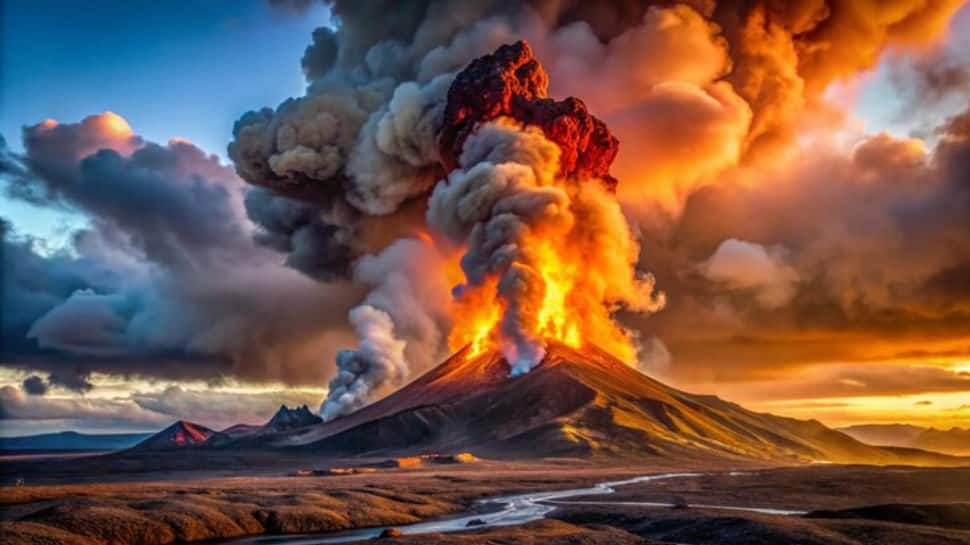Science
Scientists Uncover Urgent Threat of Yellowstone Supervolcano Eruption

Recent research has revealed alarming insights about the Yellowstone Supervolcano, suggesting that an eruption could occur much sooner than previously anticipated. Advanced imaging techniques have uncovered significant magma reservoirs beneath Yellowstone National Park, leading scientists to warn of potential global climate consequences. The implications of such an eruption could mirror the catastrophic events depicted in disaster films, with the potential to disrupt life across North America and beyond.
New Discoveries Raise Alarm
Utilizing cutting-edge electromagnetic imaging, researchers from the United States Geological Survey (USGS), Oregon State University, and the University of Wisconsin-Madison have mapped four substantial magma chambers located between 4 and 11 kilometers below the surface. These chambers are filled with rhyolitic magma, a type known for its association with explosive volcanic activity.
One particularly concerning finding is that one of the magma pockets resembles the volume of the Mesa Falls eruption, which occurred approximately 1.3 million years ago. This historical eruption significantly altered the Yellowstone landscape and had lasting effects on the climate. The northeast section of the caldera has gained increased attention from scientists, particularly after recent evidence suggested a connection between shallow rhyolitic magma and deeper basaltic magma. This interaction could potentially lead to heightened volcanic activity.
Potential Consequences of an Eruption
While certain areas of the caldera are currently showing signs of cooling, experts caution that other regions may become increasingly unstable over time. Larry Mastin, a volcanologist at the USGS, emphasized that while an eruption is not imminent, “things can change in decades, not just millennia.” This statement underscores the unpredictability of volcanic systems and the need for ongoing monitoring.
If a super-eruption were to occur, classified as a VEI 8, the immediate consequences would be severe. Ash plumes could erupt into the stratosphere within minutes, blanketing regions up to 100 kilometers around the caldera. Major cities, including Chicago and San Francisco, could experience heavy ashfall, impacting millions of residents. The eruption would also release vast quantities of sulfur dioxide into the atmosphere, which could block sunlight and lead to a significant global cooling period lasting between 15 to 20 years.
Such a cooling phase would have dire repercussions for agriculture, disrupt weather patterns, and jeopardize ecosystems, potentially triggering a widespread crisis. Scientists are keenly aware of these possibilities and continue to monitor Yellowstone closely. While there are no immediate signs of an eruption, the complexity of the magma system serves as a reminder that the Earth’s most powerful natural forces can awaken unexpectedly.
-

 World5 months ago
World5 months agoSBI Announces QIP Floor Price at ₹811.05 Per Share
-

 Lifestyle5 months ago
Lifestyle5 months agoCept Unveils ₹3.1 Crore Urban Mobility Plan for Sustainable Growth
-

 Science4 months ago
Science4 months agoNew Blood Group Discovered in South Indian Woman at Rotary Centre
-

 World5 months ago
World5 months agoTorrential Rains Cause Flash Flooding in New York and New Jersey
-

 Top Stories5 months ago
Top Stories5 months agoKonkani Cultural Organisation to Host Pearl Jubilee in Abu Dhabi
-

 Sports4 months ago
Sports4 months agoBroad Advocates for Bowling Change Ahead of Final Test Against India
-

 Science5 months ago
Science5 months agoNothing Headphone 1 Review: A Bold Contender in Audio Design
-

 Top Stories5 months ago
Top Stories5 months agoAir India Crash Investigation Highlights Boeing Fuel Switch Concerns
-

 Business5 months ago
Business5 months agoIndian Stock Market Rebounds: Sensex and Nifty Rise After Four-Day Decline
-

 Sports4 months ago
Sports4 months agoCristian Totti Retires at 19: Pressure of Fame Takes Toll
-

 Politics5 months ago
Politics5 months agoAbandoned Doberman Finds New Home After Journey to Prague
-

 Top Stories5 months ago
Top Stories5 months agoPatna Bank Manager Abhishek Varun Found Dead in Well









